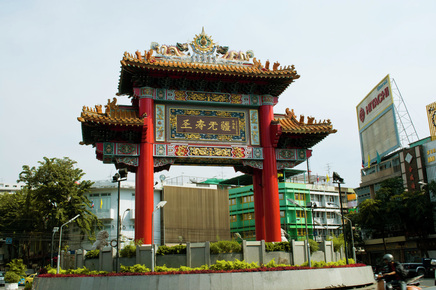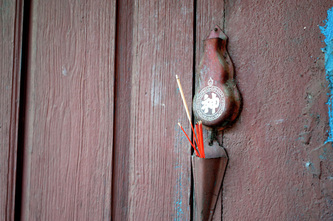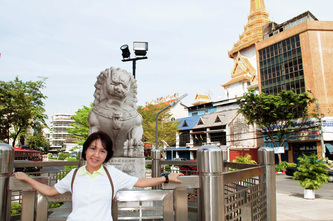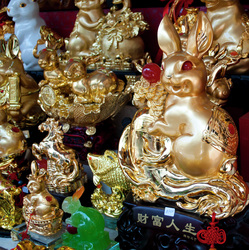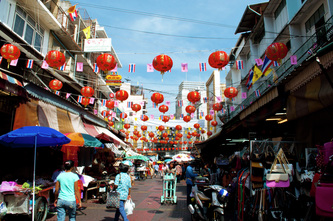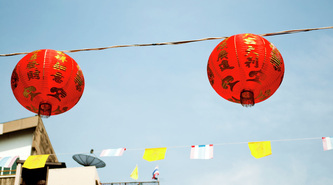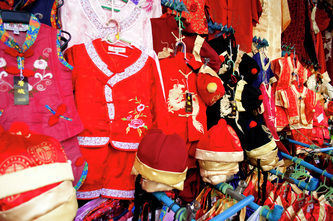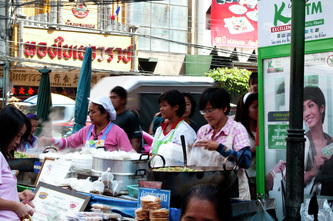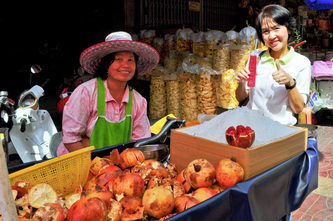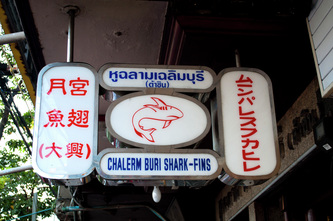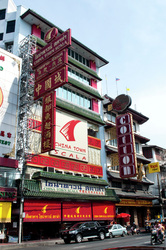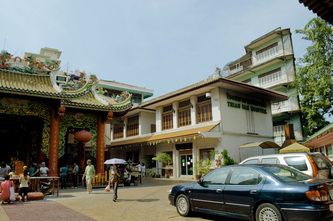"The wonderer and his Shadow!"
China town, also called Yaowarat, is situated in one of the oldest areas of Bangkok. Originally, it was gradually settled up by Chinese traders who came by junks to trade with Siam during the Sukhothai era. By the end of 1891, King Rama V had several more roads cut through the area, which are Songwat Road, Phatsai Road, Anuwong Road and Yaowarat Road. Therefore, China town does not consist only Yaowarat Road, but also cover some other roads: Charoen Krung Road, Songwat Road, Songsawat Road, Chakkrawat Road and the Wanit 1 area. However, Yaowarat Road is the center of the area. According to the Feng-Shui principle, the shape of Yaowarat Road is curvy like the dragon's curvy body, making it an ideal location for business. Many prospering businesses in Thailand originated and are still thriving in this age-old downtown. What visitors can find here vary from leading gold shops, textiles, garments, souvenirs, second-hand parts and equipment, electric goods, computer parts, antiques, imported musical instrument and definitely local delicacies.
Since China town is a very bustling area; parking space is scarce. The best way to reach there is by the public transport. Chinatown is an easy place to explore on foot, and in fact there really isn't any other way. My own suggested walking tour takes in many of the sights of Chinatown, as well as the Indian market at Phahurat and the flower market further on.
To get China Town; By Taxi take a taxi or a ‘tuk-tuk', a motorized tricycle, and get off at Trimit Road, east of Yaowarat Road, or Charoen Krung Road, parallel to Yaowarat Road at its north. Then walk towards your destinations in the China town. By Bus take buses no. 1, 4, 7, 25, 35, 40, 53, 73 and 501. The last time when we went there to take some pictures I took the Bus N° 4. By Boat Get on the boat on the Chaophraya River and alight at Ratchawong Pier. Then walk up Ratchawong Road, passing Songwat Road and Sampeng Lane (Wanit 1 Road) to reach Yaowarat Road. According to some travel agency the most best times to go there are during 4 important festivals: Chinese New Year Festival approximately on January or February; Nguan Chioew Festival held 14 days after the Chinese New Year Festival; Chinese Sart Festival on August; and Chinese Lunar Moon Festival usually held a month after the Chinese Sart Festival.
Food around China Town: China town is the paradise of food lovers who quest for Chinese cuisine. Both sides of its main street are flanked with restaurants and food vendors throughout the day. Local delicacies include Dim Sum, Teachew-style steamed Chinese mullet, shark fin in red sauce and various single noodle and rice dishes such as stir-fried noodles, casserole pork in noodles soup, rice with boiled chicken, rice with crispy pork or duck toppings, rice with curry and etc. Other appetizers and sweets are stuffed sheet noodles, pork sate, dumplings, bird's nest soup, soybean milk, lotus root juice and toasted chestnuts (locally called Kaolat). Ask for map of food shops and restaurants around the area from the tourist center on Petchaburi Road on Monday to Friday and Ratchadamnoen Nok Avenue everyday from 8.30am to 4.30pm. The last time when we visited China Town we ordered a pot (small size) of shark fin soup at street food vendor. It costed only BHT. 350 (almost USD 11). Actually this kind of food is quite expensive if you have it at a good restaurant you may pay at BHT. 1,000 or more.
Shopping around China TownGold Shops There are more than 130 gold shops along Yaowarat Road. It is why it is called the ‘Golden Road'. Originally, there were four tycoon gold shops: Seng Heng Li, Hua Seng Heng, Tung Jin Aeng and Tung Toh Gung even though new gold shops are still burgeoning on both sides of the road. Most shops are members of the Gold Merchants Association. Gold products here are not only recognized of high standard and quality with the purity of 96.5% or approximately 23 karat gold, but also of hand-made beautiful intricacy.
Talat Kao (The Old Market)Talat Kao has been the marketplace for China town for over a hundred years. It is the center of all kinds of specialties, ranging from fresh to preserved food. Chinese chefs from restaurants around Bangkok flock here each day to find the best ingredients. It can be said that it is the paradise for those who shop for fresh foods. Just right at the opposite is Talat Mai or Talat Krom Phu-tared (New Marketplace), selling the same kinds of food and products found in Talat Kao.
Wanit 1 (Sampeng) The area is usually called Sampeng within which retailers and wholesalers of textile are located. Here is Bangkok's center of textile wholesalers that sell everything about clothing making such as buttons, zippers, laces, sewing equipment, gifts, souvenirs & stationery and children & teenager products.
Chiang Kong is located in the area of Tala Noi (Noi Market). It is the hub of spare parts of cars, machinery and cheap second-hand steel products.
Khlong Thom It is where shoppers can find a variety of electronic products and components of sound equipment, computers, game players, calculators and watches. Most sellers are vendors who sell their items at a fairly cheap price. Bargaining can be done here.
Since China town is a very bustling area; parking space is scarce. The best way to reach there is by the public transport. Chinatown is an easy place to explore on foot, and in fact there really isn't any other way. My own suggested walking tour takes in many of the sights of Chinatown, as well as the Indian market at Phahurat and the flower market further on.
To get China Town; By Taxi take a taxi or a ‘tuk-tuk', a motorized tricycle, and get off at Trimit Road, east of Yaowarat Road, or Charoen Krung Road, parallel to Yaowarat Road at its north. Then walk towards your destinations in the China town. By Bus take buses no. 1, 4, 7, 25, 35, 40, 53, 73 and 501. The last time when we went there to take some pictures I took the Bus N° 4. By Boat Get on the boat on the Chaophraya River and alight at Ratchawong Pier. Then walk up Ratchawong Road, passing Songwat Road and Sampeng Lane (Wanit 1 Road) to reach Yaowarat Road. According to some travel agency the most best times to go there are during 4 important festivals: Chinese New Year Festival approximately on January or February; Nguan Chioew Festival held 14 days after the Chinese New Year Festival; Chinese Sart Festival on August; and Chinese Lunar Moon Festival usually held a month after the Chinese Sart Festival.
Food around China Town: China town is the paradise of food lovers who quest for Chinese cuisine. Both sides of its main street are flanked with restaurants and food vendors throughout the day. Local delicacies include Dim Sum, Teachew-style steamed Chinese mullet, shark fin in red sauce and various single noodle and rice dishes such as stir-fried noodles, casserole pork in noodles soup, rice with boiled chicken, rice with crispy pork or duck toppings, rice with curry and etc. Other appetizers and sweets are stuffed sheet noodles, pork sate, dumplings, bird's nest soup, soybean milk, lotus root juice and toasted chestnuts (locally called Kaolat). Ask for map of food shops and restaurants around the area from the tourist center on Petchaburi Road on Monday to Friday and Ratchadamnoen Nok Avenue everyday from 8.30am to 4.30pm. The last time when we visited China Town we ordered a pot (small size) of shark fin soup at street food vendor. It costed only BHT. 350 (almost USD 11). Actually this kind of food is quite expensive if you have it at a good restaurant you may pay at BHT. 1,000 or more.
Shopping around China TownGold Shops There are more than 130 gold shops along Yaowarat Road. It is why it is called the ‘Golden Road'. Originally, there were four tycoon gold shops: Seng Heng Li, Hua Seng Heng, Tung Jin Aeng and Tung Toh Gung even though new gold shops are still burgeoning on both sides of the road. Most shops are members of the Gold Merchants Association. Gold products here are not only recognized of high standard and quality with the purity of 96.5% or approximately 23 karat gold, but also of hand-made beautiful intricacy.
Talat Kao (The Old Market)Talat Kao has been the marketplace for China town for over a hundred years. It is the center of all kinds of specialties, ranging from fresh to preserved food. Chinese chefs from restaurants around Bangkok flock here each day to find the best ingredients. It can be said that it is the paradise for those who shop for fresh foods. Just right at the opposite is Talat Mai or Talat Krom Phu-tared (New Marketplace), selling the same kinds of food and products found in Talat Kao.
Wanit 1 (Sampeng) The area is usually called Sampeng within which retailers and wholesalers of textile are located. Here is Bangkok's center of textile wholesalers that sell everything about clothing making such as buttons, zippers, laces, sewing equipment, gifts, souvenirs & stationery and children & teenager products.
Chiang Kong is located in the area of Tala Noi (Noi Market). It is the hub of spare parts of cars, machinery and cheap second-hand steel products.
Khlong Thom It is where shoppers can find a variety of electronic products and components of sound equipment, computers, game players, calculators and watches. Most sellers are vendors who sell their items at a fairly cheap price. Bargaining can be done here.
